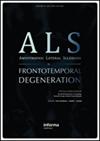A speech measure for early stratification of fast and slow progressors of bulbar amyotrophic lateral sclerosis: lip movement jitter
IF 2.8
4区 医学
Q2 CLINICAL NEUROLOGY
Amyotrophic Lateral Sclerosis and Frontotemporal Degeneration
Pub Date : 2019-11-07
DOI:10.1080/21678421.2019.1681454
引用次数: 18
Abstract
Abstract Objective: To assess the utility of novel measures derived from a rapid syllable repetition task (i.e. oral dysdiadochokinesis [DDK]) in early stratification of fast and slow progressive bulbar amyotrophic lateral sclerosis (ALS) and prediction of bulbar disease progression rate. Methods: Fifty-four individuals with ALS were tracked longitudinally on their oral DDK and global bulbar/speech performance (i.e. bulbar subscore on the ALS Functional Rating Scale-Revised [ALSFRS-R]; articulation rate during passage reading) for a four-month average duration. Based on the bulbar deterioration rate over the tracked period, the participants were stratified as 14 fast bulbar progressors and 40 slow bulbar progressors using a posteriori classification approach. To determine if oral DDK performance predicts the differential bulbar disease progression trajectories in these individuals during the early stages of the tracked period (prior to significant bulbar/speech signs), twenty-two measures of lip motor performance in an oral DDK task were derived to (1) differentiate fast and slow bulbar progressors using the Receiver Operating Characteristic analysis and (2) predict bulbar disease progression rates across all individuals using linear regressions. Results: Movement jitter, a measure of temporal variability of alternating lip movement during DDK, showed 80% sensitivity and 95% specificity in differentiating fast and slow bulbar progressors early in the disease, and outperformed the ALSFRS-R bulbar subscore and articulation rate. Movement jitter also predicted bulbar disease progression rates across participants. Conclusion: Findings provided preliminary validation of the clinical value of movement jitter during oral DDK in patient stratification and bulbar disease prognosis.快速和缓慢进展的球肌萎缩性侧索硬化症早期分层的言语测量:唇运动抖动
摘要目的:评估由快速音节重复任务(即口腔发音困难[DDK])衍生的新测量方法在快速和慢速进行性球肌萎缩侧索硬化症(ALS)早期分层和预测球疾病进展率中的效用。方法:对54名ALS患者的口腔DDK和整体延髓/言语表现(即ALS功能评定量表修订版[ALSFRS-R]上的延髓分量表;段落阅读期间的发音率)进行纵向跟踪,平均持续时间为4个月。根据追踪期间的延髓退化率,使用后验分类方法将参与者分为14名快速延髓进展者和40名慢速延髓进展者。为了确定口服DDK表现是否预测了这些个体在追踪期的早期阶段(在显著的延髓/言语体征之前)的不同延髓疾病进展轨迹,导出了口腔DDK任务中唇运动表现的22项指标,以(1)使用受试者操作特征分析区分快速和慢速延髓进展者,以及(2)使用线性回归预测所有个体的延髓疾病进展率。结果:运动抖动是DDK过程中嘴唇交替运动的时间变异性的一种测量方法,在疾病早期区分快速和慢速延髓进展者方面显示出80%的敏感性和95%的特异性,并且优于ALSFRS-R延髓分量表和发音率。运动抖动也预测了参与者的延髓疾病进展率。结论:研究结果为口服DDK过程中运动抖动在患者分层和延髓疾病预后中的临床价值提供了初步验证。
本文章由计算机程序翻译,如有差异,请以英文原文为准。
求助全文
约1分钟内获得全文
求助全文
来源期刊

Amyotrophic Lateral Sclerosis and Frontotemporal Degeneration
CLINICAL NEUROLOGY-
CiteScore
5.40
自引率
10.70%
发文量
64
期刊介绍:
Amyotrophic Lateral Sclerosis and Frontotemporal Degeneration is an exciting new initiative. It represents a timely expansion of the journal Amyotrophic Lateral Sclerosis in response to the clinical, imaging pathological and genetic overlap between ALS and frontotemporal dementia. The expanded journal provides outstanding coverage of research in a wide range of issues related to motor neuron diseases, especially ALS (Lou Gehrig’s disease) and cognitive decline associated with frontotemporal degeneration. The journal also covers related disorders of the neuroaxis when relevant to these core conditions.
 求助内容:
求助内容: 应助结果提醒方式:
应助结果提醒方式:


